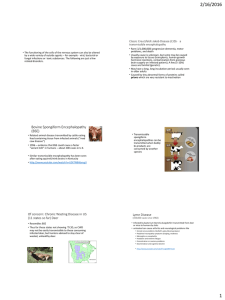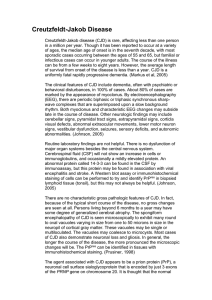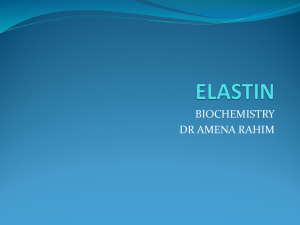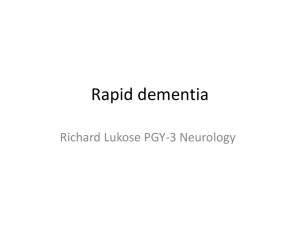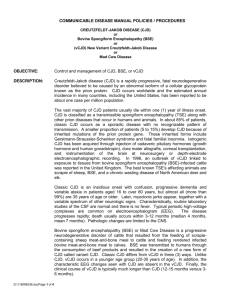Transmissible Spongiform Encephalopathies Ryan Maddox, MPH
advertisement
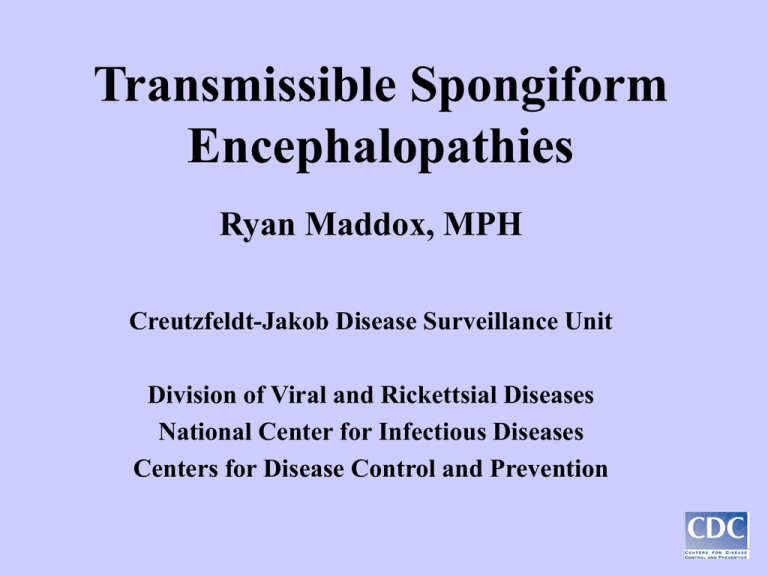
Transmissible Spongiform Encephalopathies Ryan Maddox, MPH Creutzfeldt-Jakob Disease Surveillance Unit Division of Viral and Rickettsial Diseases National Center for Infectious Diseases Centers for Disease Control and Prevention Abbreviations • TSE – Transmissible Spongiform Encephalopathy (prion disease) • CJD – Creutzfeldt-Jakob Disease • vCJD – Variant Creutzfeldt-Jakob Disease • BSE – Bovine Spongiform Encephalopathy (“mad cow” disease) • CWD – Chronic Wasting Disease Transmissible Spongiform Encephalopathies (TSEs): • • • • • Neurodegenerative diseases Rapidly progressive, always fatal Affect humans and animals Long incubation periods Brain, spinal cord, and adjacent tissues are considered infectious • Prion theory widely accepted TSEs are further characterized by: • Absence of immune response • Neuropathology may include: – – – – – Spongiform changes Reactive gliosis Neuronal loss Amyloid plaques No inflammatory reaction Human TSEs • • • • Kuru Creutzfeldt-Jakob Disease (CJD) Variant Creutzfeldt-Jakob Disease (vCJD) Gerstmann-Sträussler Scheinker Syndrome (GSS) • Fatal Familial Insomnia (FFI) Animal TSEs • Scrapie • Bovine Spongiform Encephalopathy (BSE) • Chronic Wasting Disease (CWD) Creutzfeldt-Jakob Disease (CJD) • Occurs worldwide • Annual incidence (U.S.): ~1 case per million population • Median age at death (U.S.): 68 years CJD – Clinical Features • Patients usually present with dementia, visual problems, or cerebellar dysfunction • Subsequent neurologic signs include myoclonus, tremors, and rigidity • Neurologic signs deteriorate very rapidly akinetic mutism CJD – More Features • Rapidly progressive - over 50% of CJD patients die within 6 months and 85-90% within 12 months of illness onset (median illness duration: 4 months) • CJD occurs in three different forms: – sporadic – familial – iatrogenic Sporadic CJD • About 85% of CJD patients • No recognizable mode of transmission identified • May be caused by: • Age-related somatic mutation of the prion protein gene • Error in production of the normal prion protein Familial CJD • About 10-15% of CJD patients • Autosomal dominant inheritance • Associated with prion protein gene abnormalities • Usually a family history of CJD is present Iatrogenic CJD • <1% of CJD patients • Transmission through: – Human Growth Hormone – Dura Mater Graft • Lyodura – Cornea transplantation – Use of neurosurgical instruments and EEG depth electrodes CJD Transmission • Not contagious • Not transmitted through casual contact or airborne particles CJD Transmission • CJD does not appear to be transmissible through blood – Follow-up of recipients of blood from donors subsequently diagnosed with CJD – Investigation of CJD cases with history of receipt of blood products CJD - Diagnosis • Clinical course highly suggestive – Patient’s age – Rapidly progressive disease – Family history • • • • EEG: diagnostic picture in 75% of patients CSF test to identify protein 14-3-3 Genetic studies Neuropathology required for confirmation Bovine Spongiform Encephalopathy (BSE) • First recognized among cattle in the United Kingdom in 1986 • Cases may have occurred in the early 1980s • Peaked in 1992-1993: 36,682 cases reported in 1992 alone • As of June 1, 2005, 180,800 total cases in Great Britain BSE is no longer confined to U.K. • Many other countries in Europe have reported cases – As of July 21, 2005, 945 total cases in France, 963 in Portugal, 569 in Spain, 458 in Switzerland, and 363 in Germany • Japan has reported 19 cases, and Israel reported its first case in 2002 BSE in North America • In 2003, BSE cases were reported in Canada and the United States (cow was from Canada) • Two cases reported in Canada in January, 2005: – Both cows from Alberta – One cow born October 1996, other one March, 1998 (after 1997 ruminant feed ban) BSE in North America • June 24, 2005 – USDA announces BSE case in United States – did not enter food supply BSE in the United Kingdom: Possible Causes • The practice of feeding cattle rendered animal parts was implicated • Rendered material was from either: – Scrapie infected sheep – Cattle with spontaneous BSE • In the early 1980s, rendering practices changed which might have facilitated transmission BSE: U.K. Government Actions • BSE made notifiable - 1988 • Ruminant feed ban - 1988 • Specified bovine offal ban – 1989 – Brain, spinal cord, and other high risk tissues excluded from human food • Nationwide CJD surveillance in 1990 • Cattle >30 months prevented from entering human or animal food chain - 1996 U.K. CJD Surveillance • Detected 10 CJD patients with: – Unusual clinical presentation • Young age: Median, 28 years (Range 16-39) • Psychiatric presentation followed by cerebellar symptoms • Non-diagnostic, abnormal EEG • Prolonged duration of illness (Median: 14 months) U.K. CJD Surveillance (2) • Unique neuropathology – Spongiform changes most evident in the basal ganglia and thalamus – Widespread kuru-type plaques in the cerebellum and cerebrum • The plaques had pale periphery and were surrounded by spongiform lesions U.K. CJD Surveillance (3) • U.K. surveillance unit reported that the 10 cases represented a distinct new entity, variant CJD (vCJD), based on: – – – – The unique clinicopathological features Absence of any known CJD risk factors Absence of genetic abnormalities Absence of similar cases in other countries Variant Creutzfeldt-Jakob Disease (vCJD) • U.K. government announced that the BSE agent may have spread to humans (probably through consumption of contaminated beef and beef products) – Cluster in 10 young patients – Unique to the U.K. – Consistent incubation period (9 years after BSE outbreak) – No other plausible explanation Evidence for BSE-vCJD Link • Epidemiological evidence – Geographic clustering in the United Kingdom – Absence of vCJD cases in BSE-free countries • Laboratory evidence – Experimental study using macaques – Western blot analysis of infecting prions – Experimental study using panels of inbred and cross-bred mice Variant CJD is different from CJD • Variant CJD patients tend to be much younger, present with behavioral or sensory problems, have a delayed onset of neurologic signs, and tend to have a longer duration of illness • Pathology differs between vCJD and CJD USDA and FDA • USDA and FDA have taken measures to prevent the introduction of BSE into the U.S. – Importation of ruminants from BSE-endemic countries banned, and certain cattle products restricted (1989) – Importation of live ruminants and most ruminant products from all of Europe prohibited (1997) – Mammalian-to ruminant feed ban in the U.S. (1997) USDA Surveillance • USDA tests high-risk animals • 176,468 cattle tested in 2004 • www.usda.gov FDA Regulations • Prohibited use of cattle materials at highest risk of BSE in human food, including dietary supplements, and cosmetics (2004) • High risk includes – Material from non-ambulatory, disabled cattle – Material from organs of cattle >= 30 months – Mechanically separated material Variant CJD deaths in the United Kingdom, 1995-July 1, 2005 30 Deaths 25 20 15 10 5 0 1995 1996 1997 1998 1999 2000 2001 2002 2003 2004 2005 Year of Death Deaths (confirmed or probable vCJD) Probable case - patient still living 107 deaths from definite vCJD + 43 deaths from probable vCJD (no neuropathological confirmation) = 150 6 patients with probable vCJD alive; 156 vCJD cases total (definite/probable, dead/alive) Data from http://www.cjd.ed.ac.uk/figures.htm Variant CJD deaths in France, 1996 July 4, 2005 Deaths 6 4 2 0 1996 1997 1998 1999 2000 2001 2002 2003 2004 2005 Year of Death Probable case - Patient still living Deaths (confirmed or probable vCJD) Data from http://invs.sante.fr/publications/mcj/donnees_mcj.html Variant CJD Around the World • Cases have also been reported from Canada (1), Ireland (2), Italy (1), Japan (1), The Netherlands (1), Portugal (1), Saudi Arabia (1), and the United States (1) • One of the Irish cases, the Canadian case, Japanese case, and the U.S. case were believed to have been exposed to the BSE agent in the United Kingdom CDC CJD surveillance • Conducted active surveillance in 5 areas • Periodic review of national cause-of-death data • Potential cases (iatrogenic, vCJD, etc.) reported by doctors and state public health departments • Ongoing review of clinical and pathologic records of CJD decedents aged <55 years • Collaboration with National Prion Disease Pathology Surveillance Center (NPDPSC) in Cleveland, Ohio • Collaborative surveillance of special groups Blood • Some potential donors deferred – American Red Cross defers from donating: anyone in U.K. for 3 months since 1980 or any European country for 5 years since 1980 • Blood shortage vs. potentially unsafe blood vCJD Blood-Associated Cases • So far, 2 of 48 recipients of blood components from donors who later died of vCJD have evidence of bloodborne transmission – Case 1: Donor developed vCJD >3 years after donation; recipient developed vCJD 6.5 years after transfusion – Case 2: Donor developed vCJD 18 months after donation; recipient (methionine/valine) had subclinical infection Chronic Wasting Disease (CWD) • Known natural hosts: deer (Odocoileus species) and Rocky Mountain elk • Clinical symptoms – – – – Weight loss Behavioral changes Excessive salivation Difficulty swallowing CWD • Most animals die within several months of onset • Wide range of ages affected • May be highly transmissible within a population, but mode of transmission is not fully understood – Direct: animal-to-animal contact – Indirect: causative agent in environment Chronic Wasting Disease Among Free-Ranging Deer and Elk by County, United States CWD transmissible to humans? • Belay ED, Maddox RA, Williams ES, Miller MW, Gambetti P, Schonberger LB. Chronic wasting disease and potential transmission to humans. Emerg Infect Dis 2004;10:977-84. • Investigation of “clusters” of CJD cases • Collaborative project with Wyoming Case Age Year Codon 129 Western Blot Final diagnosis Endemic? 1 2 3 4 5 6 7 8 9 10 11 12 25 26 28 28 28 30 54 55 61 63 64 66 2001 2001 2002 1997 2000 1999 2002 1999 2000 2002 2002 2001 MV MM nd MM MV VV VV MM MM VV MM MM Type 1 Type 2 nd nd Type 1 Type 1 Type 2 Type 1 Type 1 Type 1 Type 1 Type 1 GSS 102 CJD GSS 102 CJD CJD CJD CJD CJD CJD CJD CJD CJD Yes No No No No No No No Yes No Yes No Is CWD affecting humans? • • • • Unique pathology among suspect cases? More human TSE cases in endemic areas? Common genetics among suspect cases? History of exposure to deer and elk with CWD? For more on prion diseases: • www.cjdsurveillance.com – Information on National Prion Disease Pathology Surveillance Center (NPDPSC) – established by CDC and AANP – NPDPSC provides free, state-of-the-art diagnostic testing • www.cdc.gov/ncidod/diseases/cjd/cjd/htm – Links to various prion disease articles and sites Acknowledgements CDC • Dr. Larry Schonberger • Dr. Ermias Belay • Dr. Jim Sejvar • Mr. Bob Holman • Mr. Aaron Curns NPDPSC • Dr. Pierluigi Gambetti • Ms. Carrie Harris State health department personnel
